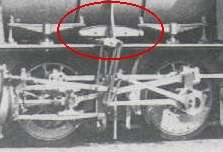Equalising beam
An equalising beam, equalising lever or equalising bar[note 1] (German: Ausgleichshebel or Ausgleichhebel) links the suspension of two or more adjacent axles of a vehicle with more than two axles, especially railway locomotives. Its job is to provide 'compensated' springing,[1] i.e. to ensure an even and statically determinate distribution of load to all the axles on uneven terrain or poorly laid track. The function of an equalising lever thus corresponds roughly to that of axle compensators or rockers (Achswippen).

Railcar bogie, with equalising beam

Equalising beam on a Prussian T 3
Notes
- Or "equalizing" beam,etc.
gollark: PotatOS may need major reworks soon™ as I found a somewhat wide ranging possible sandbox escape regarding provided APIs.
gollark: I mostly just rewrite stuff by components, it's much easier.
gollark: Why even rewrite then?
gollark: There's one known in-the-wild exploit, another alleged one, and one hypothetical one I thought of when working on some other components.
gollark: It might not, really, assuming I do most things the same.
References
- Semmens, P.W.B. and Goldfinch A. J. (2003). How Steam Locomotives Really Work, Oxford and New York, OUP, pp. 242-243. ISBN 978-0-19-860782-3.
This article is issued from Wikipedia. The text is licensed under Creative Commons - Attribution - Sharealike. Additional terms may apply for the media files.